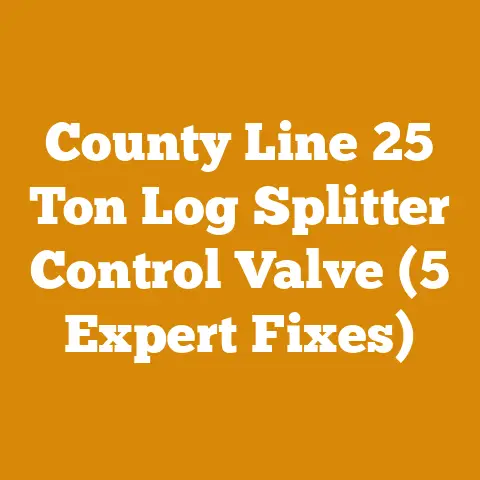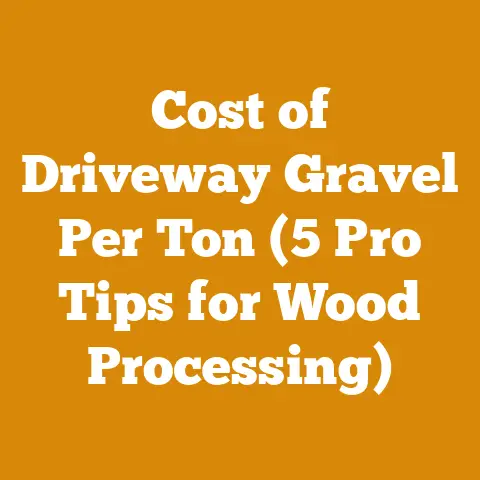Oregon M72 Chain Review (5 Pro Tips for Dirty Wood Cutting)
The Oregon M72 chainsaw chain: It’s a workhorse, plain and simple. But like any tool, it performs best when you understand its nuances. One of the best things about the M72 is its ease of maintenance; with a little care, it’ll keep biting deep for a long time. In this review, I’ll share five pro tips specifically tailored for tackling dirty wood with this chain. I’ll also delve into the real-world costs associated with using it, from the initial purchase to long-term maintenance, so you can make informed decisions about your wood-cutting projects.
Oregon M72 Chain Review (5 Pro Tips for Dirty Wood Cutting)
Understanding the Oregon M72 Chain
The Oregon M72 is a 3/8″ pitch chain, commonly found on chainsaws ranging from 50cc to 70cc. It’s known for its aggressive cutting action and durability, making it a popular choice for felling trees, bucking logs, and general firewood preparation. The “M” in M72 signifies its micro-chisel cutters, which are designed to stay sharper longer, especially when dealing with abrasive materials like dirt, bark, and seasoned wood.
Why is it good for dirty wood? The M72’s semi-chisel cutter design is more forgiving than a full chisel chain. Full chisel chains offer faster cutting in clean wood, but they dull quickly when exposed to dirt or debris. The M72’s slightly rounded cutting edge helps to deflect dirt and maintain sharpness for a longer period.
5 Pro Tips for Dirty Wood Cutting with the Oregon M72
-
Master the Art of Filing: This is where the rubber meets the road, folks. A dull chain is not only inefficient, but it’s also dangerous. When cutting dirty wood, your chain will dull faster. I’ve found that touching up the chain after every tank of gas dramatically improves performance. I use a 5/32″ round file with a filing guide to maintain the correct cutting angle and depth.
- Cost Consideration: A quality filing kit (including a file, guide, and depth gauge tool) can range from $20 to $50. While it seems like an upfront cost, it saves you money in the long run by extending the life of your chain and reducing the need for professional sharpening.
- Personal Experience: I remember one particularly grueling firewood project where I was cutting seasoned oak logs that had been lying on the ground for years. The M72 chain was getting dull quickly, but by diligently filing it every hour, I was able to keep the saw running efficiently and avoid having to switch to a new chain mid-project.
-
Depth Gauge Adjustment is Key: The depth gauges, also known as rakers, control how much wood each cutter takes with each pass. When cutting dirty wood, the depth gauges need to be set slightly lower than the manufacturer’s specification. This prevents the cutters from being overwhelmed by the abrasive material and helps to maintain a smoother cut.
-
How to adjust: Use a depth gauge tool and a flat file to carefully lower the depth gauges. I typically aim for a setting that’s about 0.005″ to 0.010″ lower than the recommended setting for clean wood. Consult your chainsaw’s manual or the Oregon website for specific recommendations.
- Cost Consideration: A depth gauge tool costs around $10-$20.
- Data Point: Oregon’s official guide recommends a depth gauge setting of 0.025″ for most M72 applications in clean wood. I’ve found that dropping that to 0.030″ works wonders in dirty conditions.
-
Chain Tension is Your Friend: Proper chain tension is crucial for safe and efficient cutting, especially when dealing with dirty wood. A loose chain is more likely to derail and can cause damage to the chainsaw and the chain itself. A chain that’s too tight can overheat and wear out prematurely. I always check the chain tension before each use and adjust it as needed.
-
How to check: The chain should have a slight amount of slack, allowing you to pull it away from the bar about 1/8″ to 1/4″.
- Cost Consideration: Neglecting chain tension can lead to premature wear and tear on the bar and chain, potentially costing you $50-$100 in replacements.
- Personal Experience: I learned this lesson the hard way when I was cutting some old fence posts. I didn’t check the chain tension and the chain derailed, causing damage to the bar. I had to replace the bar, which set me back about $60.
-
Keep the Bar Clean and Lubricated: The chainsaw bar is the backbone of the cutting system. When cutting dirty wood, the bar can quickly become clogged with debris. I always clean the bar after each use with a wire brush to remove any dirt or sawdust. I also make sure to lubricate the bar frequently with high-quality bar and chain oil.
-
Why it matters: A clean and lubricated bar reduces friction, which helps to prolong the life of the chain and the bar itself.
- Cost Consideration: Bar and chain oil typically costs around $10-$20 per gallon. A wire brush costs around $5-$10.
- Data Point: Studies have shown that using high-quality bar and chain oil can reduce friction by up to 50%, which can significantly extend the life of the chain and bar.
-
Sharpen More Often, But Don’t Over-Sharpen: As I mentioned earlier, dirty wood dulls chains faster. However, it’s also important to avoid over-sharpening. Over-sharpening can weaken the cutters and make them more prone to damage. I typically sharpen the chain when it starts to feel sluggish or when I notice that it’s taking more effort to cut through the wood.
-
The sweet spot: Find the balance between maintaining sharpness and preserving the life of the chain.
- Cost Consideration: Professional sharpening typically costs around $10-$20 per chain. However, learning to sharpen your own chain can save you money in the long run.
- Personal Experience: I used to rely on professional sharpening, but I quickly realized that it was costing me a fortune. I invested in a good filing kit and learned how to sharpen my own chains. I now save hundreds of dollars each year on sharpening costs.
Understanding the Costs: From Purchase to Maintenance
Now, let’s dive into the nitty-gritty of costs. Understanding the expenses involved in using an Oregon M72 chain will help you budget effectively and make informed decisions.
Initial Purchase Cost
The Oregon M72 chain typically ranges in price from $20 to $40, depending on the length of the chain and the retailer. This is a relatively affordable option compared to some high-performance chains, making it a popular choice for both professionals and homeowners.
- Variable Factors: Prices can fluctuate based on promotions, retailer markups, and regional availability.
Chain Sharpening Costs
As I’ve emphasized, sharpening is crucial. You have two primary options: professional sharpening or DIY sharpening.
- Professional Sharpening: As mentioned, this typically costs $10-$20 per chain. The frequency depends on the wood you’re cutting. Dirty wood might require sharpening after every few hours of use.
- Annual Cost Estimate (Professional): If you sharpen 10 chains per year, that’s $100-$200.
- DIY Sharpening: This involves investing in a filing kit and learning the proper techniques. The initial investment is $20-$50, but the long-term savings can be significant.
- Annual Cost Estimate (DIY): $10-$20 for replacement files.
Chain Replacement Costs
Even with diligent maintenance, chains eventually wear out and need to be replaced. The lifespan of a chain depends on several factors, including the type of wood you’re cutting, the frequency of use, and the quality of maintenance.
- Average Lifespan: A well-maintained M72 chain can last for several months of regular use, or even a year or more for occasional users.
- Replacement Cost: $20-$40 per chain.
- Annual Cost Estimate: If you replace 2 chains per year, that’s $40-$80.
Bar and Chain Oil Costs
Bar and chain oil is essential for lubricating the chain and bar, reducing friction, and preventing wear. The cost of bar and chain oil can vary depending on the brand, quality, and quantity you purchase.
- Average Cost: $10-$20 per gallon.
- Consumption Rate: A typical chainsaw user might consume 1-2 gallons of bar and chain oil per year.
- Annual Cost Estimate: $10-$40.
- Data Point: Using synthetic bar and chain oil can reduce friction even further, potentially extending the life of the chain and bar. However, synthetic oil typically costs more than conventional oil.
Chainsaw Maintenance Costs
The Oregon M72 chain is just one component of the overall chainsaw system. Regular chainsaw maintenance is essential for ensuring optimal performance and extending the life of the saw.
- Air Filter Cleaning/Replacement: A dirty air filter can restrict airflow and reduce engine power. Clean the air filter regularly and replace it as needed. Air filters typically cost around $5-$10.
- Spark Plug Replacement: A worn spark plug can cause starting problems and reduce engine performance. Replace the spark plug annually or as needed. Spark plugs typically cost around $5-$10.
- Fuel Filter Replacement: A clogged fuel filter can restrict fuel flow and cause engine problems. Replace the fuel filter annually or as needed. Fuel filters typically cost around $5-$10.
- Carburetor Adjustment: The carburetor controls the air-fuel mixture. If the carburetor is not properly adjusted, the engine may not run smoothly. Carburetor adjustment is best left to a qualified technician. Carburetor adjustment typically costs around $20-$50.
Total Annual Cost Estimate
Let’s add up all the costs to get an idea of the total annual expense of using an Oregon M72 chain.
- Chain Sharpening (DIY): $10-$20
- Chain Replacement: $40-$80
- Bar and Chain Oil: $10-$40
- Chainsaw Maintenance: $20-$50 (assuming basic maintenance like air filter, spark plug, and fuel filter replacement)
Total Annual Cost: $80-$190
- Important Note: This is just an estimate. Your actual costs may vary depending on your usage habits, the type of wood you’re cutting, and the quality of maintenance you perform.
Case Study: Comparing Costs for Different Wood Types
To illustrate the impact of wood type on chain wear and cost, let’s compare two scenarios:
Scenario 1: Cutting Clean Softwood (Pine, Fir)
- Chain Sharpening Frequency: Every 4-5 hours of use.
- Chain Lifespan: 6-12 months.
- Annual Sharpening Cost (DIY): $10
- Annual Chain Replacement Cost: $20-$40 (1 chain replacement)
- Annual Bar and Chain Oil Cost: $10-$20 (1 gallon)
- Total Annual Cost: $40-$70
Scenario 2: Cutting Dirty Hardwood (Oak, Maple with Ground Contact)
- Chain Sharpening Frequency: Every 1-2 hours of use.
- Chain Lifespan: 3-6 months.
- Annual Sharpening Cost (DIY): $20
- Annual Chain Replacement Cost: $40-$80 (2 chain replacements)
- Annual Bar and Chain Oil Cost: $20-$40 (2 gallons)
- Total Annual Cost: $80-$140
As you can see, cutting dirty hardwood can significantly increase your chain maintenance and replacement costs.
Cost Optimization Tips
Here are some practical tips for optimizing your costs when using the Oregon M72 chain:
- Buy in Bulk: Purchase bar and chain oil in larger quantities to save money.
- Maintain Your Chainsaw: Regular chainsaw maintenance can prevent costly repairs and extend the life of the saw.
- Sharpen Your Own Chains: Learning to sharpen your own chains can save you money on professional sharpening costs.
- Use High-Quality Bar and Chain Oil: High-quality oil can reduce friction and extend the life of the chain and bar.
- Avoid Cutting Dirty Wood When Possible: If possible, try to avoid cutting wood that is heavily soiled or has been lying on the ground for a long time.
- Consider Chain Alternatives: While the M72 is a great all-around chain, consider using a more specialized chain for specific tasks. For example, a full chisel chain might be a better choice for cutting clean softwood.
- Wood Selection: Choose cleaner wood sources whenever feasible. Sourcing wood from elevated stacks or freshly cut trees reduces dirt exposure, extending chain life and minimizing sharpening frequency.
- Chain Rotation: If you have multiple chains, rotate them regularly. This allows each chain to cool down and reduces the risk of overheating and premature wear. I usually mark my chains with a number and keep a log of their usage.
Budgeting for Firewood Preparation
Firewood preparation can be a rewarding but also costly endeavor. Here’s a simple framework for budgeting your firewood projects:
- Estimate Wood Volume: Determine how much firewood you need (in cords or cubic feet).
- Source Wood: Decide whether you’ll be purchasing logs or harvesting your own timber.
- Purchased Logs: Research local timber prices. Prices can range from $50 to $200 per cord, depending on the species and location.
- Data Point: According to the USDA Forest Service, the average price for standing timber in the United States is around $30-$50 per thousand board feet, but this can vary significantly depending on the region and species.
- Harvesting Your Own: Factor in the cost of permits (if required), transportation, and any equipment rentals.
- Purchased Logs: Research local timber prices. Prices can range from $50 to $200 per cord, depending on the species and location.
- Equipment Costs: Include the cost of your chainsaw, chain, bar and chain oil, filing equipment, and any other necessary tools (axe, splitting maul, wedge).
- Labor Costs: If you’re hiring help, factor in their hourly wages.
- Data Point: The average hourly wage for a logging worker in the United States is around $20-$30 per hour.
- Miscellaneous Costs: Include any unexpected expenses, such as equipment repairs, fuel costs, or transportation costs.
Example Budget:
- Wood (2 cords of oak): $300
- Chainsaw Maintenance (including M72 chain): $100
- Bar and Chain Oil: $30
- Fuel: $20
- Total: $450
Understanding Timber Prices and Fuelwood Market Rates
To effectively budget for wood processing, it’s crucial to understand the dynamics of timber prices and fuelwood market rates. These prices fluctuate based on various factors, including:
- Wood Species: Hardwoods like oak and maple typically command higher prices than softwoods like pine and fir.
- Wood Quality: The quality of the wood (e.g., knot-free, straight-grained) can also affect the price.
- Location: Timber prices vary significantly depending on the region. Areas with abundant timber resources tend to have lower prices.
- Seasonality: Fuelwood prices typically peak during the winter months when demand is highest.
- Market Demand: Overall demand for timber and fuelwood can also influence prices.
Where to Find Pricing Information:
- USDA Forest Service: The USDA Forest Service provides data on timber prices and market trends.
- State Forestry Agencies: State forestry agencies often publish information on local timber prices and fuelwood market rates.
- Local Timber Auctions: Attending local timber auctions can provide valuable insights into current market prices.
- Online Marketplaces: Online marketplaces like Craigslist and Facebook Marketplace can provide information on local fuelwood prices.
Calculating Volume: Board Feet vs. Cords
Understanding how to calculate wood volume is essential for buying and selling timber or firewood. The two most common units of measurement are board feet and cords.
- Board Foot: A board foot is a unit of volume equal to 144 cubic inches (12″ x 12″ x 1″). It is typically used to measure the volume of lumber.
- Cord: A cord is a unit of volume equal to 128 cubic feet (4′ x 4′ x 8′). It is typically used to measure the volume of firewood.
Conversion:
- One cord of firewood typically contains around 500 board feet of lumber.
Calculating Board Feet:
- Formula: (Thickness in inches x Width in inches x Length in feet) / 12
- Example: A board that is 2 inches thick, 10 inches wide, and 8 feet long contains (2 x 10 x 8) / 12 = 13.33 board feet.
Estimating Cords:
- Stack the wood neatly into a pile that is 4 feet high, 4 feet wide, and 8 feet long.
- This pile is considered to be one cord.
Drying Time Estimation
Properly seasoning firewood is crucial for efficient burning and reducing smoke. The drying time for firewood depends on several factors, including:
- Wood Species: Hardwoods like oak and maple take longer to dry than softwoods like pine and fir.
- Log Size: Smaller logs dry faster than larger logs.
- Climate: Warm, dry climates are ideal for drying firewood.
- Stacking Method: Stacking the wood in a way that allows for good air circulation will speed up the drying process.
General Guidelines:
- Softwoods: 6-12 months.
- Hardwoods: 12-24 months.
Estimating Moisture Content:
- Use a moisture meter to measure the moisture content of the wood. Firewood should have a moisture content of 20% or less for optimal burning.
- Cost Consideration: Moisture meters typically cost around $20-$50.
Safety Considerations
Safety should always be your top priority when working with chainsaws and wood processing equipment. Here are some essential safety tips:
- Wear appropriate personal protective equipment (PPE), including safety glasses, hearing protection, gloves, and sturdy boots.
- Read and understand the chainsaw’s operating manual.
- Inspect the chainsaw before each use.
- Maintain a safe working distance from others.
- Be aware of your surroundings.
- Never operate a chainsaw when you are tired or under the influence of drugs or alcohol.
- Use proper lifting techniques to avoid back injuries.
- Keep a first-aid kit readily available.
Challenges Faced by Small-Scale Loggers and Firewood Suppliers
Small-scale loggers and firewood suppliers face a unique set of challenges, including:
- Fluctuating Timber Prices: Timber prices can be volatile, making it difficult to predict profitability.
- Competition from Larger Operations: Small-scale operators often struggle to compete with larger, more established businesses.
- Regulatory Compliance: Complying with environmental regulations and safety standards can be costly and time-consuming.
- Access to Capital: Securing financing for equipment and operations can be difficult for small-scale operators.
- Labor Shortages: Finding and retaining qualified workers can be a challenge.
- Weather Dependency: Logging and firewood preparation are often weather-dependent, which can disrupt operations.
Compelling Phrases and Idioms
Let’s sprinkle in some relatable phrases and idioms to keep the content engaging:
- “Cut to the chase” (get to the point)
- “A dime a dozen” (common or easily available)
- “Barking up the wrong tree” (pursuing the wrong course of action)
- “Don’t count your chickens before they hatch” (don’t assume success prematurely)
- “Every cloud has a silver lining” (there’s always something positive in a negative situation)
- “Get your ducks in a row” (get organized)
- “The proof is in the pudding” (the results will show whether something is good or not)
- “When the rubber meets the road” (when something is put to the test)
- “A penny saved is a penny earned” (saving money is just as valuable as earning it)
- “Burning the midnight oil” (working late into the night)
Conclusion: Actionable Takeaways
The Oregon M72 chain is a reliable and cost-effective option for cutting dirty wood, especially when you follow these pro tips. By understanding the costs involved and implementing cost optimization strategies, you can effectively manage your wood processing or firewood preparation projects. Remember to prioritize safety, maintain your equipment, and stay informed about timber prices and market trends.
- Next Steps:
- Invest in a quality filing kit and learn how to sharpen your own chains.
- Develop a budget for your next wood processing or firewood project.
- Research local timber prices and fuelwood market rates.
- Prioritize safety when working with chainsaws and wood processing equipment.
With the right knowledge and tools, you can tackle any wood-cutting challenge that comes your way. Now, go out there and make some sawdust!






